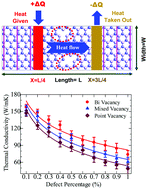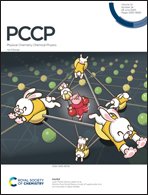Vacancy-induced thermal transport in two-dimensional silicon carbide: a reverse non-equilibrium molecular dynamics study
Abstract
Because of its impressive electrical, thermal, and mechanical properties, two-dimensional silicon carbide (2D-SiC) has recently gained tremendous attention in the field of nanoelectronics and optoelectronics. Here, we investigated the effects of various types of defects such as bi-, point-, and mixed-vacancies on the thermal conductivity of 2D-SiC using reverse non-equilibrium molecular dynamics simulation. The effects of temperature variation on the thermal conductivity of vacancy-defected 2D-SiC were also studied. A significant reduction of the thermal conductivity was observed when the concentrations of the vacancies were increased. The point vacancy resulted in the thermal conductivity decreasing more quickly as compared to bi vacancy and mixed vacancy defects. Moreover, increasing the temperature of vacancy-defected 2D-SiC further reduced the thermal conductivity due to a strong phonon-vacancy scattering effect. Because of the introduction of vacancy defects in the acoustic phonon density of states (PDOS), a softening behavior in the intensity of the characteristic peaks is perceived, and with increasing temperature, a frequency shrinking is noted in the PDOS curves, both of which contribute to the reduction of the thermal conductivity. Additionally, rapid softening of the phonon transmission spectrum and increase in entropy were obtained for the point vacancy-defected structure, which clearly confirms our findings at different vacancy concentrations as well as for types of vacancies. These findings are very much imperative for realizing heat dissipation in nano- and optoelectronic devices based on 2D-SiC as well as for demonstrating an effective method for modulating 2D-SiC thermal conductivity through defect engineering.



 Please wait while we load your content...
Please wait while we load your content...